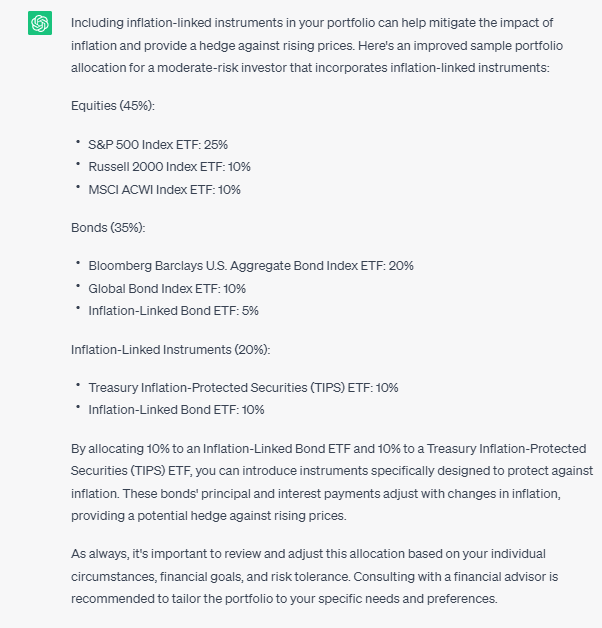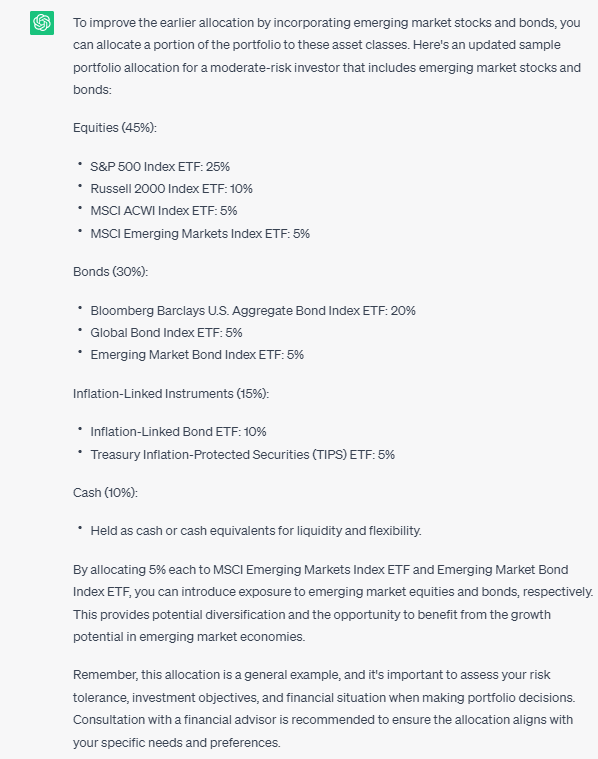Nudging ChatGPT to Build an Investment Portfolio for Long-Term Success
Human investment managers plus ChatGPT is a winning formula

When artificial intelligence (AI) first entered our lives, it mainly worked behind the scene. With the arrival of OpenAI’s ChatGPT, Google’s Bard, and other generative AI programs, AI is greeting us with open arms.
As I mentioned in this article, AI has been used in industries from media, energy, and education to financial services. With the arrival of ChatGPT, the adoption of AI will likely increase rapidly in areas such as wealth and money management, which has yet to embrace AI.
If ChatGPT can help non-professional investors invest, then professionals in the investment management industry will have to integrate AI into their investment process and workflow.
Let’s dive in.
In my profession as an investment manager, we are concerned with three essential investment functions:
Generating investment ideas
Putting the ideas together in a portfolio, assigning weights, and achieving good diversification — asset allocation.
Managing the portfolio risks
ChatGPT can potentially help in №2 — asset allocation, which is also a crucial way to generate long-term performance in a portfolio.
Please look at my conversation with ChatGPT to generate a potentially investable portfolio for a moderate-risk investor.
Building a Portfolio with ChatGPT
Question 1: I asked ChatGPT to provide a simple asset allocation based on the common market benchmarks using global bonds and equities.
MO: What are the most common performance benchmarks for mutual fund investors in equities and bonds and also in the US and globally? Please provide a simple portfolio using these benchmarks with percentage allocation for a moderate-risk investor.
ChatGPT recommended a standard 60/40 portfolio comprising 60% equities and 40% bonds, which is typically used by financial advisors for moderate-risk investors. It did a good job diversifying into large-cap (S&P 500) and small-cap stocks (Russell 2000) in the U.S. and using ETFs (passive investment vehicles.)
It also asked the investor to consider her individual circumstances when constructing a portfolio and consult a financial advisor. ChatGPT did so consistently in every answer.
Question 2: ChatGPT did not diversify its bond allocation or include any allocation to global bonds (ex-United States). I asked why.
MO: In the above portfolio you provided, why do you not include global bond allocation?
ChatGPT did what it was told and allocated 10% to global bonds. It also reduced the equity allocation by adding 10% cash.
Question 3: I was unhappy with the diversification in bonds and asked if inflation-linked instruments could be included.
MO: How can you improve on the above allocation by including inflation-linked instruments?
You can see ChatGPT is pleasing and does what I asked. It allocated 20% to inflation-linked instruments but did not distinguish the two inflation-linked bonds. They are duplications.
Question 4: I questioned ChatGPT why it recommended the allocation to the different asset classes.
MO: Thanks. Can you explain why you allocate 45% to equities and the rest to bonds and inflation-linked instruments?
ChatGPT gave a decent rationale for allocation to the various asset classes, providing a balanced approach to investing.
Question 5: I nudged ChatGPT to diversify the portfolio further by investing in emerging market stocks and bonds.
MO: How would you improve the earlier allocation between stocks and bonds by adding emerging market stocks and bonds?
ChatGPT split the allocation to emerging markets equally to bonds and equities (each at 5%.)
Question 6: I then asked ChatGPT if it can consider commodities.
MO: Thanks. How about improving the above allocation by adding in commodities, including energy and gold?
ChatGPT followed my instructions and allocated to the two most popular commodities, gold and energy, but gave a large allocation of 10%.
Question 7: I challenged ChatGPT and asked why it allocated a large percentage (10%) to commodities, a volatile component for a moderate investor.
MO: For a moderate-risk investor, what do you think is the right allocation to commodities? Will you improve on your earlier allocation?
ChatGPT predictably reduced the allocation to commodities and reminded us commodities are volatile and risky and the weights should be adjusted based on the investor’s risk tolerance. It raised the inflation-linked bonds to 15%.
Question 8: To execute the portfolio, I asked ChatGPT to suggest the tickers for each position.
MO: Thank you, based on the last asset allocation, can you suggest the appropriate ETF ticker and write that ticker next to the position? Thanks.
Within 5 seconds, ChatGPT spits out the tickers for each position accurately. I was most impressed it can distinguish between U.S. bonds (AGG) and global bonds ex-U.S. (BNDX). This saves time for investors by providing efficiently the tickers to trade. For energy commodities, ChatGPT gave the ticker XLE for energy stocks rather than that for oil (it turned out fine.)
Question 9+: I then asked ChatGPT what the asset allocation would be for a conservative and aggressive investor.
Notice ChatGPT reduced equities to 35% for a conservative investor but mistakenly put a 5% allocation to commodities within equities, which is incorrect and inappropriate. It raised equities allocation to 60% accordingly for an aggressive investor and smartly allocated 5% of emerging markets stocks.
Last but not least, I backtested the portfolio for a moderate-risk investor based on the allocations in Question 8 and compared the portfolio return with that of a globally balanced benchmark (60/40).
The long-term results were impressive. However, the portfolio did not outperform the benchmark every year. In 2017, global equities performed superbly, so a 45% allocation to equities (vs. 60%) hurt the portfolio. Since the second half of 2021, the portfolio caught up with the performance beautifully due to its underweight in equities and diversification into commodities and cash. Equities were the worst performer of all asset classes, followed by bonds in 2022.
Concluding Thoughts
I have three conclusions from this portfolio-building exercise with ChatGPT:
1. ChatGPT does what you tell it to do. It does not analyze or think but provides information based on a string of data it saw before. Building a proper investment portfolio based on the customer’s risk and goals and market risks requires the guiding hand of a professional. ChatGPT is a tool to assist humans but cannot replace an experienced investor currently. It shows promises.
2. Once you have an asset allocation, ChatGPT can quickly assemble the trading instruments (ETFs) for the investor to execute the portfolio, saving time and cost. Still, the investor needs to double-check each suggestion to ensure there is no duplication in the exposure and that the asset class is appropriate.
3. For long-term portfolio success, diversification holds the key. It is not enough to include U.S. bonds and equities but to consider international stocks and bonds, emerging markets, inflation-linked instruments, and commodities. More importantly, finding the investment universe that aligns with the investor’s goals and risk profile is crucial. This exercise highlights a more nuanced approach to asset allocation is necessary.
This article is for informational purposes only. It should not be considered financial or legal advice. Consult a financial professional before making any major financial decisions.
The author is a co-founder, partner, and portfolio manager at Lumen Global Investments and has been investing in the global markets for over 25 years.


















JP Morgan recently filed a trademark for IndexGPT which is a digital AI tool to help consumers select securities. In fact, JP Morgan is exploring 300 use cases for AI across its business.
Morgan Stanley is doing something similar but as an investing AI expert for its 16,000 advisors.
GPT4 is capable but these specially trained custom AI tools will fit more with business objectives and compliance requirements.
This is very intriguing! I believe that with sufficient data and the appropriate "language", it's entirely possible to develop a more specialized Asset Manager GPT.
For instance, consider feeding GPT more market-related inputs such as rates, yields, or even just telling it that the current environment closely resembles a particular time period, and see if GPT tailors its recommendations based on the input.